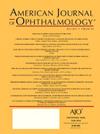Racial and Ethnic Disparities at Enrollment in DRCRnet Clinical Trials for Diabetic Macular Edema
IF 4.1
1区 医学
Q1 OPHTHALMOLOGY
引用次数: 0
Abstract
Purpose
To assess racial/ethnic disparities and association with diabetic macular edema (DME) characteristics at enrollment in DRCR Retina Network (DRCRnet) DME clinical trials.
Design
Retrospective, cross-sectional analysis of data from DRCRnet clinical trials.
Subjects
5468 participants in 17 DRCRnet DME trials (2003-2020).
Methods
The racial and ethnic distribution of DRCRnet DME trial participants was compared to United States census data and DME prevalence data in the CDC's Vision and Eye Health Surveillance System (VEHSS). Generalized linear models were used for comparing demographics, HgbA1c, diabetic retinopathy (DR) severity, and visual acuity (VA) among racial/ethnic groups, and for determining factors associated with VA.
Main Outcome Measures
Racial and ethnic distribution of DME trial participants; patient and ocular characteristics at enrollment.
Results
Compared to VEHSS (64% White, 16% Black, 4% Asian, 14% Hispanic) and the 2020 U.S. census (62% White, 12% Black, 6% Asian, 19% Hispanic), White (76%) participants were over-represented, and Asians (2%) and Hispanics (12%) were under-represented (P < .001) in DME trials. HgbA1c was higher in Black and Hispanic (8.3) than in White (7.7) and Asian (7.6) participants (P < .001). More Asian (20%) and Hispanic (23%) participants had proliferative DR than White (19%) and Black (15%) participants (P < .001). Hispanic ethnicity, female gender, older age at diabetes diagnosis, and severe DR were independently associated with worse VA (all P < .05).
Conclusions
Hispanic participants, while under-represented, had higher HgbA1c, more severe DR, and worse VA than other groups, emphasizing the need for diverse recruitment in DME trials.
求助全文
约1分钟内获得全文
求助全文
来源期刊
CiteScore
9.20
自引率
7.10%
发文量
406
审稿时长
36 days
期刊介绍:
The American Journal of Ophthalmology is a peer-reviewed, scientific publication that welcomes the submission of original, previously unpublished manuscripts directed to ophthalmologists and visual science specialists describing clinical investigations, clinical observations, and clinically relevant laboratory investigations. Published monthly since 1884, the full text of the American Journal of Ophthalmology and supplementary material are also presented online at www.AJO.com and on ScienceDirect.
The American Journal of Ophthalmology publishes Full-Length Articles, Perspectives, Editorials, Correspondences, Books Reports and Announcements. Brief Reports and Case Reports are no longer published. We recommend submitting Brief Reports and Case Reports to our companion publication, the American Journal of Ophthalmology Case Reports.
Manuscripts are accepted with the understanding that they have not been and will not be published elsewhere substantially in any format, and that there are no ethical problems with the content or data collection. Authors may be requested to produce the data upon which the manuscript is based and to answer expeditiously any questions about the manuscript or its authors.

 求助内容:
求助内容: 应助结果提醒方式:
应助结果提醒方式:


